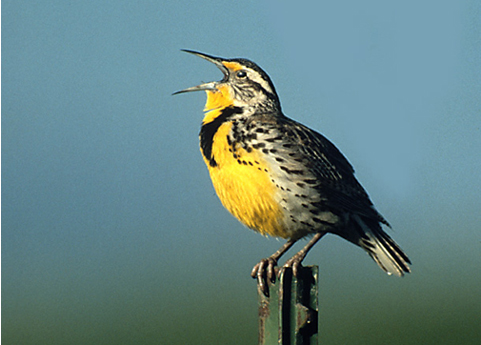All the men, except for a small group at the camp below the Great Falls of the Missouri, haul the first dugout canoe across the portage route. The wagon needs frequent repairs, and after dark, they abandon the heavy boat and hike the remaining ½ mile to the White Bear Islands. Lewis notices slight differences in the Western species of Meadowlark.
First Leg of the Portage
by Yellowstone Public Radio[1]Originally aired weekdays by Yellowstone Public Radio during the Bicentennial observance of 2003-2006. Narrated by Hal Hansen. Scripts by Whit Hansen and Ed Jacobson. Produced by Leni Holliman. © … Continue reading
Portage of the Great Falls
© Michael Haynes, https://www.mhaynesart.com. Used with permission.
Plains Prickly Pear
Opuntia macrorhiza
Location: The Grand Fall, 21 July 2011. © Kristopher K. Townsend. Permission to use granted under the Creative Commons Attribution-Share Alike 4.0 International license.
First Leg of the Portage
This morning early Capt Clark and myself with all the party except Sergt. Ordway Sharbono [Charbonneau], Goodrich, york and the Indian woman [Sacagawea], set out to pass the portage with the canoe and baggage to the Whitebear Islands, where we intend that this portage shall end. Capt. Clarke piloted us through the plains.
—Meriwether Lewis
Wagon Repairs
we were obliged here to renew both axeltrees and the tongues and howns of one set of wheels which took us no more than 2 hours. these parts of our carriage had been made of cottonwood and one axetree of an old mast, all of which proved deficient and had broken down several times before we reached this place we have now renewed them with the sweet willow and hope that they will answer better.
—Meriwether Lewis
Fatigued and Wounded
after dark we had reached within half a mile of our intended camp when the tongues gave way and we were obliged to leave the canoe, each man took as much of the baggage as he could carry on his back and proceeded to the river where we formed our encampment much fortiegued. the prickly pears were extreemly troublesome to us sticking our feet through our mockersons.
—Meriwether Lewis
York and Charbonneau Hunt
large gangs of buffalow all around the lower Camp to day. one gang Swam the river near the camp Capt. Clarks Servant York killed one of them . . . . our Interpreter [Charbonneau] wounded a cabberee or antelope [pronghorn] this evening.
—John Ordway
Western Meadowlark
there is a kind of larke here that much resembles the bird called the oldfield lark with a yellow brest and a black spot on the croop; tho’ this differs from ours in the form of the tail which is pointed being formed of feathers of unequal length;
—Meriwether Lewis
Weather Diary
State of the thermometer at rise
Weather Wind at rise
State of the thermometer at 4 OC. P.M. Weather Wind at 4 OC. P. M. State of river 45 [above 0] cloudy S W 54 [above 0] fair S W fallen ½ in. wind not so violent. Thermometer removed to the head of the rappid and placed in the shade of a tree.
—Meriwether Lewis[2]To assist the reader, the editor of this web page has omitted the date column, merged the “State of the river” columns, and spelled out some abbreviations.
The Great Falls Portage is a High Potential Historic Site along the Lewis and Clark National Historic Trail managed by the U.S. National Park Service. It includes Sulpher Spring (open to the public) and Lower Portage camp site (private land), and the Upper Portage Camp Overlook.
Notes
| ↑1 | Originally aired weekdays by Yellowstone Public Radio during the Bicentennial observance of 2003-2006. Narrated by Hal Hansen. Scripts by Whit Hansen and Ed Jacobson. Produced by Leni Holliman. © 2003 by Yellowstone Public Radio. |
|---|---|
| ↑2 | To assist the reader, the editor of this web page has omitted the date column, merged the “State of the river” columns, and spelled out some abbreviations. |





